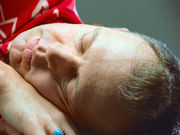Linear combination of mean oxygen saturation, expiratory breathing predicts FEV1
WEDNESDAY, Dec. 9, 2015 (HealthDay News) — For patients with sleep disordered breathing (SDB), expiratory snoring predicts obstructive airway disorders, according to a study published online Dec. 2 in the Annals of the American Thoracic Society.
Abdulrazak Alchakaki, M.D., from the John D. Dingell VA Medical Center in Detroit, and colleagues examined whether the presence of airflow obstruction could be predicted by the presence of expiratory upper airway narrowing during sleep among 93 males with SDB. Patients underwent in-lab polysomnography and complete pulmonary function tests.
The researchers found that patients with expiratory snoring had increased odds of having evidence of lower airway obstruction, defined as forced expiratory volume in one second (FEV1)/forced vital capacity (FVC) ratio <70 (odds ratio, 11.03; P < 0.001), with smokers also having increased odds (odds ratio, 13.18; P < 0.001). There was a positive correlation for FEV1 with mean arterial oxygen saturation (SaO2) (P < 0.05), while negative correlations were seen for FEV1 with expiratory snoring, smoking, oxygen desaturation index (ODI)-3 percent, ODI-2 percent and age (P < 0.05). Chronic obstructive pulmonary disease (COPD) (FEV1/FVC <70) was significantly related to expiratory snoring (odds ratio, 11.76) and smoking (odds ratio, 9.95). FEV1 was predicted by the linear combination of mean SaO2 and expiratory snoring.
“Patients with expiratory snoring and low mean oxygen saturation during sleep should be carefully assessed for pulmonary disorders such asthma and COPD,” the authors write.
Full Text (subscription or payment may be required)
Copyright © 2015 HealthDay. All rights reserved.








